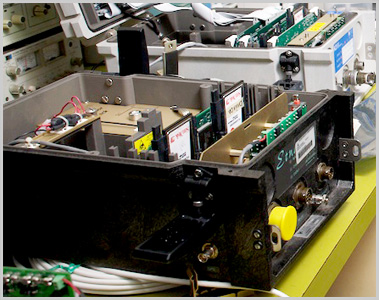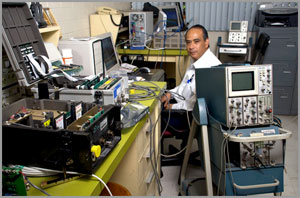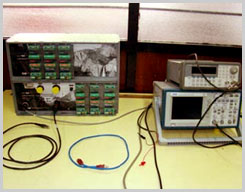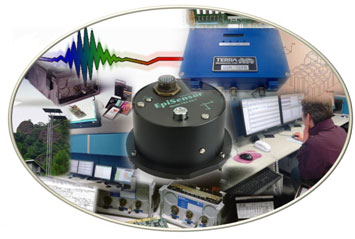
![]()
Seismic Instrumentation
_______________________________________________________
This laboratory is part of the
Seismology and Seismic Instrumentation Department.
It began operations in 1973.
The laboratory is run by
M Leonardo Alcántara Nolasco.
It is located in
Building 1, "Fernando Hiriart Balderrama"
II UNAM. Ciudad Universitaria
SCOPE
The Seismology and Earthquake Instrumentation Department maintains, operates and provides an extensive network of accelerographs installed at major seismic zones of the country. Additionally, seismic recording equipment might present variations in their calibration constants or there might be some errors in the information provided by the manufacturer in the case of new equipment due to causes related to failure during operation or simply by aging and deterioration of their electronic components, testing becomes necessary and both static and dynamic calibration is carried out to verify and correct such variations.
Another activity that is done in this laboratory is to send seismic signals in real time using standard Internet protocols and frequencies and/or satellite communication. This activity is essential for mapping seismic intensities occurred immediately after an earthquake, and it also indicates the state of operation of the equipment at all times.
Also, this laboratory is in charge of the design, building and repairing of AC power supplies and other power supply systems based on solar panels, as well as metal structures and hardware support.
ACTIVITIES
Currently the Institute of Engineering of UNAM operates the country's largest accelerographic network to record strong shaking.
In this laboratory, accelerometers' calibrations are performed , often offering suggestions for improvement to the manufacturers. There have also been designed and implemented several accelerographic networks in structures such as buildings, bridges, a section of the Bicentennial elevated viaduct , the Metropolitan Cathedral in Mexico City, the pyramid of Monte Alban and a landfill on the Texcoco area.

MAJOR WORKS AND RECENT PROYECTS
The Seismology and Earthquake Instrumentation Department has launched a process of network expansion for both free-field and structures-mounted accelerographs , so that it is in a process of verification and calibration of all instruments of recent acquisition (traditional radio frequency and satellite).
The team is continuously sending accelerographic signals in real-time and testing radio frequency communication by means of telephony, fiber optics, conventional Internet, wireless and satellite. This is associated with the implementation of systems for generating seismic intensity maps immediately after the occurrence of a seismic event, information that is provided to civil protection authorities.
Recently installed and now operating is the seismic recording system at the Centro Cultural Universitario Tlatelolco, in which new technologies are being used for computer communication such as wireless systems and optical fiber. This system is also being integrated to other accelerographic records through GPS devices.
A project currently in implementation is the instrumentation of a section of the Bicentennial Viaduct, in order to study its behavior.

EQUIPMENT
The lab equipment includes an infrastructure for field recording of earthquakes, about 106 free-field seismic stations installed in various states in addition to seismic networks in 3 sites: a vehicular bridge, the Metropolitan Cathedral of Mexico Valley and a landfill in Texcoco. The Institute has the following test equipment for calibration:
- Conventional spectrum analyzers and RF.
- Receiver and transmitter for RF testing.
- Horizontal and vertical shaking table.
- Conventional oscilloscopes and radio frequency modulators.
- Sinusoidal and random signal generators.
- Computers for testing and calibration of accelerometers
- Wattmeters, multimeters, power supplies and peripheral equipment.

SEISMIC RECORDING CENTER
An important section of the Seismic Instrumentation Laboratory is the Seismic Recording Center. It processes a large amount of data, resulting from technological advances and experience. Around 135 stations are installed in Mexico, which have generated an important historical data heritage.
The modernization and upgrading of some of the seismic stations was carried out in order to allow for the continuous delivery of the signals generated in various regions of the country to the Seismic Recording Center (SRC). Data acquisition systems implemented have allowed the integration of more than 100 channels of data in real time, even from different institutions, using different equipment brands, models and media.
These signals are received timely and reliably at the (SRC)in the II-UNAM, and they may be fed to other systems that generate maps of estimated acceleration, in order to have an immediate picture of the severity of the seismic movement both in the Valley of Mexico and nationally right after an earthquake has occurred, which provides great support for the decision making of the National System for Civil Protection in the assistance to the population.
The administration and maintenance of these systems as well as providing continuous service by various means to interested parties is carried out by the personnel of this laboratory.
The information obtained at the SRC is carefully analyzed and processed semi-automatically, by developing systems that integrate relevant parameters for the correct and reliable data transformation to a standard format for broadcast. Also, the center continually develops systems for consultation and information management.
For the proper operation of the accelerographic network, there are activities that allow the constant monitoring of data received, which provides the opportunity to identify problems at the stations and finding the proper solutions by implementing specific tools used for both the health status monitoring as well as for the process control.
MAJOR WORKS AND RECENT PROYECTS
The works mentioned are the product of the participation of diverse groups and departments:
- Automatic publishing of estimated acceleration maps in the Valley of Mexico
- Automatic publishing of likely-to-be-damaged areas in Mexico City after an earthquake
- Information system for the Mexican Seismic Network for a timely exchange of data on the occurrence of earthquakes in Mexico
- Automatic publishing of nationwide maps of estimated acceleration
- Mexican Database for Strong Earthquakes (MDBSE)
- Updating and dissemination of the MDBSE in a cross platform
EQUIPMENT
It has the support of 12 computers including servers, desktops and two laptops, plus self-developed software, and specialized commercial and free software for the acquisition, analysis and seismic processing.
The infrastructure of the II-UNAM, maintained by the Department of Computer Systems is a crucial part for the recording and reporting systems, including database servers, email servers and cellular modem communication
